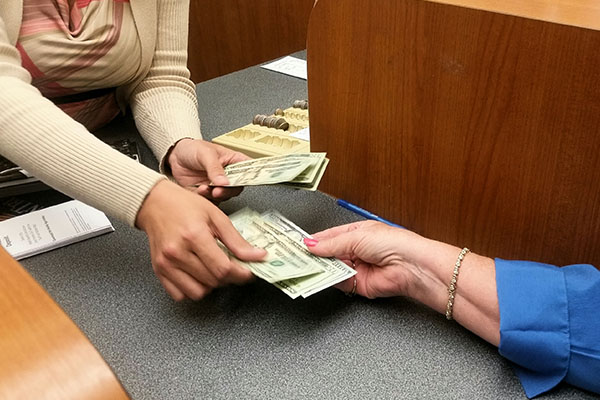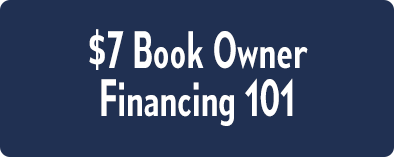PODCAST
Want More Deals? New Hidden Tax Secret With Eddie Speed
Episode 549: Want More Deals? New Hidden Tax Secret With Eddie Speed

Creative financing is a way that you can close more deals with more income and fewer headaches. There’s no crystal ball in real estate, you have to make strategies so that you can come out on top.
With Eddie Speed’s “Money Ball” strategy, you’d be able to sidestep the appreciation game that you got on the property. Sidestep paying those capital gains. Just like in the movie Money Ball, creative financing is putting a deal together and stacking the financing in a way that your competition doesn’t think about it. Invest in yourself to be a more successful buyer with this strategy. Join Mitch Stephen as he talks to Eddie about his new hidden tax secret strategy. Eddie is the President and Founder of NoteSchool. He is also the author of It’s a Whole New Ball Game with Creative Financing. Learn how you can avoid paying capital gains tax with his strategy. In a changing market, creative financing is your solution. Get on base with your seller today!
—
Watch the episode here
I’m on with Eddie Speed. This man is an icon in the note-buying business across the nation, and it has been for a long time. I don’t want to make you feel old but that’s some experience right there with over 40,000 notes representing about $3.5 billion. You do the math. For many years, it’s 40,000 notes. That’s 10,000 notes a year on average through the highs and the lows. There were years there where it was pretty dry.
That’s like everything else. It doesn’t come in on average. It goes for a little while and then keeps on top of you. You’ve got to make sure your infrastructure is ready to handle it. Maybe that’s a good thing to do when you are in slow periods. Go back and work on your infrastructure because it’s getting ready to flood. It’s like the farmers around here say, “If it doesn’t rain until September 2022, then it’s going to flood in September. Better get ready.” How are you, my friend?
Mitch, I’m good. It would not surprise you. Our phone has been ringing off the hook because the traditional real estate investor who has not been into creative financing very much all of a sudden is figuring out that’s something he needs a clear definition of.
We go way back to the early 2000 or before, even 1996, 1997 or 1998. We have been through a lot of cycles. We went through the recession. We then went through COVID. We are still standing, and that says a lot to anybody who’s still standing after those major events. How do you weather those tough times?
You said a lot of things. You had to be prepared for it. The first thing now is mental. I work with a lot of vendors that work with active real estate investors like fractional CFOs, companies that do business management implementation, and guys that do coaching for negotiations. Within those vendors, it’s very comfortable to say it’s probably all of the top 1,000 house buyers or clients of multiple of those vendors or some of those vendors. I spend a lot of time talking to them about, “What are your clients need? What are they feeling?” I talked to your partner. I was talking about the same thing.
You are talking to my partner Mike.
I’ve only known you for years. I’m talking to your partner Mike. We are talking about, “This is what I’m trying to get a sense of now.” You and I know what they need to help them but it may not be the first thing we do because they are a little bit scared of learning something too complex. How do you learn something simple to start out and then lead to something that could be a little more creative?

Creative Financing: A very unique scenario happened in the house-buying business in March of this year. 80% of the biggest 500 house buyers had the house that they were wholesaling up on Wall Street.
Let’s talk about that creative side. That’s how I’ve managed to survive because I keep morphing. If it’s not working, you got to shift. For the longest time, before we were good at raising private money, we were trying to get these sellers to finance the properties. We were going about it all wrong for many years.
In everything we’ve tried, people say, “How do you come up with this idea?” It wasn’t the first idea. You and I have talked about the tax strategy. Believe me, that wasn’t my first approach of trying to get somebody to carry terms and seller finance me when I’m buying from them. I didn’t think of a tax angle. It’s just one little piece at a time tied together, and after you do something for a long time, the solution you come up with sounds simple but not the first idea.
It’s always evolving, changing, shifting, and trying new things. How do you describe your business now? Who is Eddie Speed nowadays? We have been in a lot of things over the years. What are your focuses?
We have a real estate investing business that typically ends up being a joint venture with other investors in various ways. I have a very active land business that you are aware of. I have been in the land business for many years. I did a lot of land deals down in South Texas. I used to come to fly to San Antonio, come by your office, see you, and drive clear to the border. We were selling land tracks on the border, from Eagle Pass all down to Uvalde. I have been doing that for a long time. How did I meet those guys? I met those guys because they created owner-finance notes and would end up at my doorstep with those notes.
We would figure out a way to work together, even at the point of buying the land and reselling it. I ended up doing that a lot with real estate investors. I have a very active land business up here doing a similar thing. The truth of the matter is the land guys that I partner with don’t need me. I’m just glad they liked me because they are plenty capable of doing all of it by themselves. I work a lot with real estate investors at the moment. Let’s go back a little bit. What had happened in the house-buying business was a unique scenario.
I recall it was March of 2022. Probably 80% of the biggest 500 house buyers, that house they were wholesaling was ending up with Wall Street money. You are saying, “Is that true? Wall Street was paying $1.10 of value.” On the surface, that sounds a little crazy but they had a strategy where they were renting it, securitizing the rental, and they could make math work that the average person couldn’t. They say they could. All that has happened, and the market started going sideways. Apparently, there was a problem. You can’t buy a house at a 4% cap in a 7% rate market.
I never figured out how they were buying these houses with a $3,000 margin with all the things, the unknowns, and the variables. I didn’t understand how that was even going to work. I thought they were gambling on the odds.
What is the strongest indication of real estate values? Back then it was supply and demand. Right now, it's affordability. Share on XWhen you are a bond house and securitizing, you make a lot of money putting it into the security. There are a lot of upfronts they make. The average person can’t make that but the bond house can. If you are asking me their motivation in doing it, it’s pretty clear to me. It’s the reason I did mortgage securities back in early 2000. Finally, they securitized all the good papers and had to start working on bad papers. We saw where that led us.
What has happened was Wall Street has pulled back. I talked to what I believe are the biggest operators in the business that we are selling to these groups. They say all the Wall Street money has left. All of a sudden, you got up essentially a corporate buyer that was paying retail plus, which meant if you were wholesaling, you didn’t have to buy at a very deep discount to make a good spread. They hit the easy button. The other thing is the other buyers that we are typically buying from real estate investors if you were flipping houses were not the old seasoned landlords.
The guys that own 50 rentals haven’t been aggressively buying in the last few years. The guys buying the last few years are smaller operators trying to get in the game. Once again, people confuse mortgage rates and the Fed rates. The Fed controls what they lend money to banks. That’s what we hear about the Federal Reserve raising the Fed rate and so forth. That’s the rate that they charge to licensed banks. Mortgage rates are bond-driven. It’s just bond trading. The biggest investor of these bonds for a good long time has been the government.
The biggest buyer of these long-term mortgage bonds that essentially drives mortgage rates was the government. They pull back, and now we have a weird situation where sometimes somebody will come in with a big amount of dry cash and buy the market, and people are like, “Do you see that? Mortgage rates are going down.” All of a sudden, they spike back up, and the people are like, “I thought mortgage rates were going down.” I have a friend that works for a big Wall Street firm. They manage mega bonds. He’s a hunting buddy. If you are a hunting buddy, that’s the closest.
He’s helpful to me. They spend a lot of money, call it millions of dollars, hiring analytics firms to study all these things. The trend of the Wall Street firms looks like this, not somebody on Facebook that’s got a HotSports opinion. It looks like we are going to see mortgage rates increase. There may be dips at the moment but an increase up probably through the first quarter of 2023, maybe tailing off around February 2023, capping out at somewhere around 7.5% to 7.3% quarters. We are going to see a slide back in rates around a 1% slide. Call it 6.5%. That is for what they see for the foreseeable future. This 2% or 3% mortgage thing that we got so used to call it over.
That’s what’s causing a little bit of the low in the house now. People are trying to get over the sticker shock. They don’t know what to do now. They used to be able to afford a $350,000 house. Now, they are going to have to bring that number down.
Two things have to happen. Rates have to drop, and our prices have to drop. It’s because, at the new mortgage rate, we’ve had an unaffordability crisis. We had an unaffordability crisis back in June 2022. Rates had even quite gotten to 6%, and yet there were all these reports show in the affordability factor and how people couldn’t afford to buy a house. That’s because we built the housing market pricing based on artificially low rates.

Creative Financing: People confuse mortgage rates and fed rates. The fed controls how they lend money to banks. That’s the rate that they charge to licensed banks, while mortgage rates are bond driven.
There has never been a time like that in history when rates were so low. Remember the days when they were 18% in the Carter years in the ’70s?
Here’s a fun fact. Do you know the average long-term mortgage interest rate over the last many years?
I’m going to guess around 8% but I’m just guessing.
That’s a heck of a good guess. It’s 7.7%.
It’s because they were high for some years but didn’t stay low all that long compared to the chart you’re looking at. What does this do for the seller financers out there? What are they thinking? I can tell you what I’m thinking.
There’s a theory. This theory pretty much always proves to be true. When conventional lending is very aggressive, either with cheap money or loose money, which is not a good underwriting, we saw loose money in 2008. We saw cheap money in 2021. When that happens, there’s not much of a need for seller financing. Conventional lending is solving the biggest problems in the industry. There’s no gap to fill. There’s no void to fill in. When the mortgage industry, on the other hand, is not filling the gap, there is a scarcity. It is not a scarcity of available money.
Although the mortgage underwriting is continuing to get tighter, the scarcity is the cost of money that were not affordable. When you see that, you look at trends over time. You are saying, “When was the most seller financing created?” If you look historically over the past years, you can almost say, “The mortgage industry had a problem. Seller financing doubled. Look over here. Years later, the mortgage industry had a big problem. Seller financing doubled.” That’s generally the pattern. I hadn’t asked you, but I assume what we are both thinking now is seller financing is going to fill the gap, and conventional lending doesn’t fill it.
For the hardest questions, the first answer is never the right answer. You need to think through it a little bit. Share on XThis is my personal experience. I don’t know across the country. I happen to live in a state in the city that probably had some of the most affordable, nice housing on the planet for years and years. I was very blessed to be in this place at the time that I arrived on the real estate scene. I never had any trouble seller financing my houses. I averaged 4 or 5 days on the market, maybe 9 days sometimes. Do you have any statistics on how many people can’t qualify for a new loan?
The Mortgage Bankers Association keeps a chart called the Mortgage Credit Availability Index. This index measures all these variables. We won’t get into what all the variables were. Before the virus started, call it February of 2020. That index was at 185. Nowadays, that index is right around 115. That means that they have tightened up who can get a mortgage. That index doesn’t measure who can afford it. That’s simply underwriting standards, assuming your income compared to your payment is in line.
You’ve had time on the job, and you check all the boxes, documented income, and all that stuff. There seem to be a million reasons why people who can’t afford it, who can’t get along, still are out there looking for houses. It brings me to this next topic. The theory that is out there they don’t see how house prices can drop because we still have a shortage of houses. In San Antonio, it was 30 days’ worth of houses on the MLS. That’s all there was. That’s one theory but the rates are going up. How do those two theories, when the rates go up, people are going to have to drop the prices of their houses? How do those two theories collide? What happens when those two theories collide?
I started in 1980, so a couple of months ago, I had been in the business for at least 40 years. If you called me a couple of months ago and said, “Eddie, what is the strongest indication of real estate values? What’s the pattern you’ve always noticed, the one common thread?” I would have said supply and demand. Most people with any experience would say, “Supply and demand is your strongest indicator.” If you call me now and say, “Eddie, what is the strongest indicator of value?” I would say affordability.
What’s happened is we’ve put ourselves in a weird situation. Our friends in Texas in East are operating with, “Those old guys are crazy. There’s no way real estate is going to go down in value.” Call people out West. Call people in Boise, San Diego, and Phoenix. Ask them. I talked to a guy in Phoenix. I was preparing for this interview. I called a student. He’s a high-volume guy. He was dropping 100,000 pieces of mail a month.
He’s got a fairly big perspective of the market. He says, “Eddie, I had a house that I put under contract in April 2022 for $575,000.” He said, “It was a 4-bedroom, 3-bath house in Tempe, Arizona, where the college is. I had it flipped to an investor for $625,000. I was going to make $50,000. The investor called me and said, ‘I’m out. I don’t want to buy.'” There was a cycle time. He says, “I don’t want to buy it.” He says, “No big deal. I’ve got a big buyer’s list. People are wearing me out. I used to put an offering out and have 25 investors look at the house and pay me more than I offered 100% of the time.”
He said, “I sent it out at $550,000. I called the seller and told him that things had changed. I needed to see what I could do but I knew I was going to have to adjust the price. I re-offered this property to my closest network of investors at $550,000. I couldn’t get a single response. I thought I would be wild and try something and see because I thought I would start an Army in the front yard wanting to buy. I made the initial offering to my investor group at $475,000. It’s $100,000 below what I bought it for at a wholesale price a few months ago. I got two people to call me, and they weren’t willing to go out and look at it.”

Creative Financing: With Wall Street, mortgage rates are going to increase. It’ll increase through the first quarter of next year, capping out at somewhere around 7 1/2 to 7 3/4. Then it’ll slide back.
He was trying to cause a frenzy in the front yard. They would drive the prices up, and then he would go over what he had in it but it didn’t turn out that way.
When I started the conversation with him, I said, “How do you feel out there?” He said, “I don’t see a big drop in price. It’s the weirdest I’ve ever seen. It is cold. It’s like a ghost town out here but I don’t see a big drop in price.” I said, “That’s interesting. Why don’t you say that?” We went through how he was feeling about it, and I led him up to this conversation. When he got done with the conversation, I said, “You say there’s no chance of a price drop. You just run your own experiment.” There was only 1 house and 1 deal, and maybe everybody was on vacation, or who knows? The idea is that this is when creative financing becomes such a tool because there are so many different things you can do with it.
There’s a landlord strategy. The landlords owned the house. Let’s say there are 1,000 house buyers. They are the top 1,000 guys in the business. They are all making a living doing it. They are doing a certain amount of volume, some a lot more than others but they are all doing it. They all would say that the most motivated sellers they find are landlords because they don’t like managing the rental. They figured out it was a way more of a job and didn’t know how to do it. Their call flow is all up. Pretty much now, at the moment, people are saying their call flow is about double what it was in February 2022.
What do you mean by call flow?
They are doing marketing, and their response rate is that much more. Guess what the problem is. The sellers are calling them wanting yesterday’s pricing. Price is a price. This is where the guys we are working with are like, “I now need to know how to make creative offers to make part of the price of that property with monopoly money and not real cash.” It’s a creative structure. It’s a price on the closing statement but the way you are paying it back is almost monopoly money.
In layman’s terms, you are saying you can pay the high price if you can get some favorable terms so you can offset the price.
It doesn’t have to be all of the deal. Maybe you got them to carry a piggyback second with no interest, no payments, and due way out in the future. You can keep that deal on the property, even if you flip it to somebody else, and they take over the financing that you structured. There are all ways to do it. People always think, “The landlord has to carry all the financing for me. That’s the only way it can be done.” The answer is that’s not true. If we are having this conversation in January 2022, most people in the house flipping business are like, “This gives me a headache. I don’t want to learn this.”
People that are making demands on the interest they want to earn could not take a financial calculator and calculate the payment. Share on XNow, guess what? They are showing up for these workshops and things that we do. They say, “Tell me more.” Here’s what I like about it. They are willing to reinvent themselves. They have to see that they need to reinvent themselves. That’s pretty much become evident. With that being said, they are saying, “While I didn’t need to know creative financing, now I’m willing to learn it.” We’ve got a new generation coming along, and some old dogs like us have been doing it a long time and get the chance to help them.
I want to mention the book that you have. Tell us a little bit about your book.
The book is about buying on terms. It’s how you buy with creative financing. It’s a nice book. It’s got a good opening and about six chapters. Every chapter is a different way it could be done. It’s just some good examples. It’s an easy read. It’s not going to take somebody forever to read it. Along with that, I’m going to give them a little workshop. I’m going to introduce an idea to them.
This workshop is pretty cool because it introduces the idea of a tax strategy that most real estate investors have never considered. I pretty much have brought this to the market. It’s so simple. People have been doing this for years. A landlord has a unique strategy where it’s possible that they never have to pay capital gains tax if they are willing to carry payments over a period.
You stretch out your payments. You stretch out when you get your capital gain. In most cases, capital gains tax doesn’t start until you make a certain amount of capital gains in any one year. You don’t start paying capital gains tax at the first dollar in capital gains you earn. You have to get to a certain threshold, and above that, you pay capital gains tax. You are taking a couple of Tax Laws and tying them together. It’s something that the guy was selling the properties, probably his number one concern, is paying taxes but never thought about how to do it. He’s never had anybody show him that was possible.
The other thing good about landlords is they are used to taking payments. They understand the collateral. They are used to getting payments. We would like to see a cashflow going, especially if they’re 70 years old or up in years. They say, “I will be able to ride this out for the next twenty years or whatever.” Whether your note goes that long depends on how things are written, I like that about landlords. You don’t have to explain a first lien position to them. You don’t have to explain what their rights are if they don’t get paid as agreed. They understand all this already. What they probably don’t understand is, “How to avoid the big tax from my cash sale or a new loan sale?”
You sit with them and say, “Prices here or there, I’m okay there. Have you considered what this is going to do to your income tax-wise if you take it all and start to back into showing them how they might avoid that big hit?” In essence, you are setting yourself up for them to let their light bulb go off. You are trying to get them to come to a conclusion through your coaching that you probably don’t want to sell this for cash. You probably want to sell this with seller financing and avoid this mess.

Creative Financing: When conventional lending is very aggressive, either with cheap money or with loose money, there’s not much of a need for seller financing. Conventional lending is solving the biggest problems in the industry.
You are making the IRS strategy become their reason. They are required to carry seller financing to accomplish this instead of you saying, “I’m going to pay you your price but you got to take my terms.” That’s a much harder negotiation. The other thing about it is people say, “Why would I do all this?” The reason you are doing it is that you are getting the seller to carry financing terms that are way below market rates.
All of a sudden, your ability to create cashflow out of these properties is drastically different. There are people that are what if-ers like, “What if this? What if I change?” That’s why we have these classes. We take it way down the trail and show you, “What if this happened? Where would you be? How would you position it? How could you safety yourself?” We show them stuff that we have been studying for a long time. They say that in the hardest question, the first answer is never the right answer. You got to think through this stuff a little bit.
I have a course called Private Money Changes Everything. It was about raising private money. The unique thing about the course was, first of all, that it wasn’t heavy, bulky or thick. It was just rich. It’s probably the only seller financing course I know of that has seller financing as the backdrop. I’m in the business of seller financing to my buyers. Now, I want to borrow some money from you. Let me show you how it works with seller financing as my business, not being a landlord, not fixing and flipping, or all those different things. I need longer terms but can offer a longer cashflow, great loan-to-value, and all this stuff. In that course, I had the 21 objections I’ve ever heard.
I had the 21 objections and the answers to those objections based on the owner finance strategy. I find when people have an objection, you can come real easy and smooth with answers. They usually don’t come back with anything else. They’ve shot their bullet, and that’s it. You came back with a logical answer. It’s very important to know the answers to the objections in any negotiation in what you are talking about so that it rolls off your tongue easily. You are confident. You don’t have to say, “Let me check on that and get back to you,” because that’s not a good way to negotiate. The answers to the objections are everything.
One of the strategies that I teach a lot is doing that strategy what you are talking about is where you got a private investor first mortgage, and the seller carries second. He doesn’t carry all the financing. He maybe got 50% of the price of the property upfront but then he gets a second lane. Sometimes we split them into two notes. One of them has an interest, and one of them has no interest. One of them has payments, and one has no payments, or he is carrying almost a 2nd and 3rd lane. I can wrap that and create a cashflow model that otherwise wouldn’t work in this market. That’s an example of what you are describing.
If you could buy a property cheap enough, you can always pay cash, buy at a discount, get a private loan, and do a wrap. As prices go up in value, all of a sudden, you start struggling with the math. That’s where I’m saying you can pay a different price depending on how you structure the terms. There’s not a customer volume problem nowadays. As I understand it, house buyers’ call flow is better than it has been in quite a long time. The problem is the customer is not in the mindset of, “I’m willing to take a big discount.” We’ve got to train them that prices have gone up.
One of the first things we start asking questions to find out is, “What’s this guy’s button?” If his button is priced, we can forget all the other stuff. Once you determine that his button is, “I’m going to get this number, and that’s my number,” most people walk away at that point.
Creative financing is putting a deal together and financing in such a way that your competition doesn't think about it. Share on XHere’s what I’ve learned. People always start out with these big demands. Virtually all sellers that say they are willing to seller finance and you show them some tax strategy or some reason that’s a big motivation, they start laying out what all their criteria is, “I’m willing to do it but I’ve got to have 5% interest. I’m willing to do it, and I have to have 25% down.” That’s all normal. Some guy that’s new at creative financing thinks, “I’ve hit these big walls.” Those walls are there every time you start the deal. Let me tell you something.
I can show you several hundred case studies of guys we’ve coached that all started with this gigantic, “This is what I want.” I can show you the final deal that was negotiated. Part of it is knowing some strategies of what to counter with in a way that is unique. Let me give you one simple example. A guy is stuck on the interest rate. He’s stuck on 5% interest, “I will carry the terms but I have to have 5% interest.” What you do is structure a step rate deal and say, “I’m going to need you to work with me on the interest. If you work with me, I’m willing to work with you. I will give you more than 5%.”
Here’s the deal. On the big principle amount, the most money is going to be a low rate like 1% or 2%. As the principal goes down, we raise the rate. You are paying higher interest but on a lower principal amount. I can get to the point where on the very backside of the deal, I can pay him 6% interest. You are thinking, “Eddie, you are crazy.” No, I know how the math works.
That’s very ingenious. Is this stuff hard to implement or hard to get people to understand? Do they hear that you are going to give them the interest rate or even lower it, and all of a sudden, they soften up?
Here’s what I’ve learned. Most people that are making demands on the interest they want to earn could not take a financial calculator and calculate the payment. What they are stuck on is what they believe is a factor. They don’t even know what that means to them. One of the things I’ve done along the way is I built some pretty cool spreadsheets that allow you to insert different numbers and timeframes. It calculates the payment that shows them, “Your payment can be this and this.”
As you said, a landlord was looking for a monthly check, not an invoice from the air conditioning company. There are no expenses related to this check. You just get the check. Building the models would be complex for a beginner to do but it’s fairly easy for them to follow the model I’ve already built. I build some cool stuff and show them how it works. All of a sudden, they are sitting down with the customer and saying, “First of all, if you are trying to avoid taxes, this is not the time to charge the most interest because that interest you collect is going to be subject to ordinary income.”
You are doing all the disclaimers that you are not giving them tax advice and legal advice, and they got to see whoever that is and stuff. You are pointing out things to ask their advisor that they wouldn’t know to ask them. What we’ve learned is people wouldn’t even know to bring it up. Their accountant does not call them and say, “There’s some cool tax strategy where you could probably sidestep paying capital gains.” They are like, “What?” Your accountant never called and said that to you, Mitch?

Creative Financing: A landlord has a unique strategy where it’s very possible that they never have to pay capital gains tax. But they have to be willing to carry payments over a period of time.
I had to teach my accountant how to do all this.
That’s the real world.
I will pay him so I can teach him how to do it.
That’s my life experience, too, and every other seasoned guy I know. We are showing them things that are not bogus. We verify this with the right people with the right license. We are not saying something stupid or ridiculous. We are pointing it out to them. As we go down the road, we are showing them, “This is what you can get.” It relates back to what you said. When people buy a rental, what they will want is income.
They weren’t looking for a headache. They ended up with a headache, and they didn’t get near as much income as they thought because they had surprise expenses. You are flipping the deal and saying, “You are going to get income with no headaches. There’s a cool strategy here that would probably allow you to sidestep this appreciation game you got on the property, this capital gain.”
That will get their attention, for sure. I’m going to put you on the spot. You don’t happen to have a copy of your book there. Do you?
I’m not like you. I don’t have the whole thing. I can’t reach back there. I could dig around but we would have to probably take the coffee break.
You need to structure deals based on the story that the customer's telling you. Share on XWe are good. Tell us the name of the book, so you guys can get your hands on it and have an opportunity to go to 1 of this 3-day bootcamp or courses.
We start with a free workshop and explain some concepts. If they want to progress down the road, they can figure out if it’s a fit for them. We want to give them something free. The book is called the Moneyball book. I copied the idea of the Brad Pitt movie Moneyball. If you think about it, that’s what we’re doing. It’s real estate in a whole new way. The idea of the Moneyball theory is that he went and made the team the second lowest paid team in baseball. He kicked all the high-price players off the team and took guys statistically that were as good but weren’t in the club somehow.
That’s what creative financing is. It’s putting a deal together and stacking the structuring of the financing in such a way that your competition doesn’t think about it. They don’t know how to do it. Whoever acts on this, there’s going to be 30 people that don’t act on it because the little voices are going to be going off in their head, “This is too complicated. I can’t do this. I don’t know how.” That never ran you off. You said, “I’m going to do this,” and I know for a very good fact it has been good to you.
What I loved about the Moneyball thing is they started picking people that got on base. They weren’t sending records but they got on base all the time. They had statistics. If you can get on base, the chances of getting into home plate are good. We are going to learn how to get on base, which means getting the interest of the seller and giving him something to think about.
Tell them something they haven’t ever thought about before. Get on base with this guy. That also builds confidence. This guy is no dummy. If you are a seller, and a person is speaking to you with this intelligence, you got to say, “This guy is going to make the payments. He’s too smart to screw this up. He’s got something going for him. He studied. He knows what he’s talking about.”
What we’ve done is what you described. We’ve heard a lot of objections. We structure offers. When we get to a three-day class, we do case studies. Sometimes, the setup before I even get into the math of the case study might take 20 or 30 minutes. I’m describing what you are talking about. They had an objection, and you got to move them past this and stuff. We are explaining and digging through and showing people the objections that people have and the fronts they throw up if that’s not really their objection. They just say that. You’ve seen that a million times.
You said you must back up and go through 30 minutes of backstory. The reason why that is important is you’ve got to size up the personality of this guy, where he’s from, how he thinks, is he red, yellow, or green? Where is he at? How am I going to talk to him in his language? It takes a long time to pull that out of a person, if I or anybody else, for that matter.

Creative Financing: There’s not a customer volume problem today. Real house buyer’s call flow is better than it’s been. The problem is the customer is not in the mindset of being willing to take a big discount.
Let’s go out there and say, “We offered him this much and ended up taking that much. We made this much money.” The art of the deal was how you get there, who he was, what was his personal personality like, and how you learn to recognize these things so that you can talk to a person in their own language, figure out where their hot button is, scrap everything else, and try to do within that parameter, and you will have the guy’s attention. The backstory is huge.
It’s the art of the deal. I have practice structuring and whiteboarding out deals and ways to structure financing things. This is what I’ve practiced for many years. I don’t expect somebody to show up and have the competency level of structuring deals that I do because they don’t have the numbers behind them. When you’ve structured tens of thousands of deals, you can think at a faster pace. We are pretty good at doing that but structuring the deal that nobody else is willing to agree to is ridiculous. It doesn’t matter. You got to structure deals based on the story that the customer is telling you that says, “If we do this, this is what you get. This is what you could accomplish.”
A book that changed my life was Nothing Down by Robert Allen, which was much like that. It’s describing in detail the person and where the chink in the armor or the crack was that you are going to try to slide through. I have known you for a long time. You are a great storyteller. It makes it interesting. With all those experiences over all those years, you use the things that even the pretty savvy investor is not going to pick up because you have years of experience. I try to explain that to my own students if I’m doing a one-on-one. I said, “Start talking to me and tell me what your conversation with this guy is like.”
All of a sudden, I’m starting to pick up, either this is the angle you go or, “You have a con man here. I’m not even sure this guy owns the house. He’s not answering the questions right. Let’s check this guy out.” Go to 1000Houses.com/EddieSpeed. You are going to get a free copy of the book, Moneyball. You are also going to be offered an opportunity to follow up on this and get some real-life case studies and some conversation with a man who has been there and done it. Where do you have these classes? Are they virtual? Are they face to face?
We are still virtual. We’ve made virtual work so well. Honestly, we just made it work. We think in that space, we’ve become about as good at it as anybody has done it. We had never done it before the virus but we have gotten a very engaging class. They come online and hang out with us. There were live events. It’s not fake live. It’s real live.
I love the question and answer because when you are speaking to an audience, the audience can come up with some pretty unique what-ifs. I always find that interesting. Sometimes those what-ifs aren’t going to happen but a lot of times, they do or they could. I like those formats. I love that you are virtual also because it makes it easier for a person to get there.
It makes it easier for them to get there, and it makes it easier on my staff. My team has been with me for a long time. I don’t have any newbies on my team. The lowest tenure we’ve got is probably five years. The highest is 10 years, probably 18 to 20 years. My team has been loyal in helping our students, and they all actively do the business. It lets them come Monday morning and get back in the business, doing what we are teaching. We have become fired up about it. We’ve worked hard at a lot of exercises that we do. We are able to bring a lot of the students’ business to the class, not just us being a talking head.
I love real-life situations because the problem with hypothetical case studies is that the tree branches can branch off so much that you even forget what you are talking about. When you have a student with a real problem or a real case study, all of a sudden, the variables become finite. They are not infinite. They are finite. You can figure out where the chess pieces are on the board.
You can now say, “If the battlefield looks like this, what are we going to do?” I love that because real case studies are finite. You can set the board. Is there anything else we need to mention before we wrap it up, Eddie? Again, for you guys out there, it’s 1000Houses.com/EddieSpeed. There will be contact information and information about his virtual three-day course. It’s a way to click to get the book. It’s one link that does it all.
One decision people need to make is, in a changing market, is creative financing a solution that would allow me to close more deals? If the answer is yes, this is probably going to help you.
I don’t see how it couldn’t. I might go myself, Eddie.
I wish you would.
I have been here with Eddie Speed. We’re talking about morphing into the new situation. There’s always a new one right around the corner. Nowadays, we are headed into a situation. Nobody has a crystal ball but these strategies can’t do anything but improve your chances and make you a more confident, aggressive, and successful buyer. It makes sense. Don’t be afraid to invest in yourself. I have been to seminars like this and spent a beaucoup of money. Every single time, I made my money back because I paid attention, went out in the field, and took action. It always paid me.
I have never wasted any money on a high-caliber person because they always have something to bring to the table. I’m open enough to say, “I got to change what I’m doing a little bit and morph.” Check it out, 1000Houses.com/EddieSpeed. I would like to thank all of you for reading. Thank you for doing all those downloads. You make this show exciting and get it out there. I appreciate each and every one of you. We are out of here, Eddie. I will talk to you in a bit.
Important Links
About Eddie Speed
 Eddie Speed knows how to architect a deal like the back of his hand. For almost 40 years, he has personally bought more than 40,000 notes and his NoteSchool’s executive team has bought 3.5 billion dollars in notes. As an esteemed teacher of real estate investment, Eddie’s innovative methods have earned him multiple industry awards and earned him a spot as the inaugural inductee into the Small Balance Real Estate Hall of Fame. He has spoken at events across the country–teaching thousands of people how to find freedom and flexibility in their lives through a widely untapped and extremely profitable part of real estate investment: creatively buying and selling notes.
Eddie Speed knows how to architect a deal like the back of his hand. For almost 40 years, he has personally bought more than 40,000 notes and his NoteSchool’s executive team has bought 3.5 billion dollars in notes. As an esteemed teacher of real estate investment, Eddie’s innovative methods have earned him multiple industry awards and earned him a spot as the inaugural inductee into the Small Balance Real Estate Hall of Fame. He has spoken at events across the country–teaching thousands of people how to find freedom and flexibility in their lives through a widely untapped and extremely profitable part of real estate investment: creatively buying and selling notes.
At his core, Eddie is a problem solver. He is skilled at identifying roadblocks most investors couldn’t work around, and finding solutions to creatively close in a way that’s exponentially profitable. With humble roots growing up Jackson, Mississippi putting in long hours working in the stockyards. At the heart of Eddie’s business is family. He has a passion for helping families in America build a financial legacy for generations to come. That’s why in 2003, he founded NoteSchool, a real estate coaching program designed to teach investors how to scale their businesses through buying and selling performing and non-performing notes.
Over the past decade, he’s helped countless investors expand their portfolios by the millions using his out-of-the-box techniques. The ripple effect has been tremendous. Many of his students are able to quit their 9-5 jobs, spend more time with their families and live the lifestyle of their dreams.
Love the show? Subscribe, rate, review, and share!
Join the Real Estate Investor Summit Community:
- reinvestorsummit.com
- Real Estate Investor Summit Facebook
- Real Estate Investor Summit Twitter
- Real Estate Investor Summit YouTube
- Mitch Stephen LinkedIn









